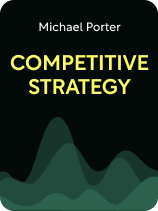

This article is an excerpt from the Shortform book guide to "Competitive Strategy" by Michael Porter. Shortform has the world's best summaries and analyses of books you should be reading.
Like this article? Sign up for a free trial here.
Why is there so much competition in entrepreneurship? How do competitors pose a threat to your sales?
Without competition, most businesses wouldn’t work as hard to keep themselves going. It’s the thought of another business outselling them that keeps entrepreneurs motivated to be the best and win the top seat in the market.
Let’s look at how deep competition in entrepreneurship goes, as Michael Porter describes in Competitive Strategy.
New Competitors
Porter explains that markets pose varying degrees of challenges that influence new entrants’ ability to compete against established businesses. These challenges impact both the level of competition in entrepreneurship and the potential for market disruption. For example, in the e-commerce market, storefront technologies and global shipping infrastructures make it easier for new companies to enter the market. However, markets saturated by competitors pose challenges such as building brand recognition and establishing trust.
He states that new competitors find it easier to enter a market under a number of conditions, including:
- Low entry costs. Reduced capital requirements and financial barriers make it easier for new entrants to access the market without significant upfront investments.
- Absence of significant barriers. When there are no substantial legal, regulatory, or technological obstacles in place, new competitors can enter the market more easily.
- Favorable government policies. Government initiatives and policies that promote competition, reduce regulations, or offer incentives to new entrants facilitate easier market entry.
- Accessible distribution channels. Availability of open and accessible distribution channels, such as online platforms or partnerships with established distributors, simplifies the entry process for new competitors.
Limited competitive advantage. If established businesses lack significant cost or quality advantages that are hard to replicate, it becomes easier for new entrants to compete on an equal footing.
Blue Ocean Strategy: Unlocking Market Entry
While certain conditions do present challenges for new competitors entering a market, W. Chan Kim and Renée Mauborgne’s Blue Ocean Strategy suggest that you can overcome them by creating value in uncontested market spaces. Here’s how this strategy facilitates market entry even under unfavorable conditions:
High entry costs: Businesses can identify new market spaces and redefine industry boundaries, allowing for significantly reduced or eliminated entry costs through innovative business models. For example, new entrants in the ride-sharing industry, such as Lyft and Uber, significantly reduced entry costs by using personal vehicles instead of building an expensive fleet of cars.
Significant barriers: By exploring untapped market spaces, businesses can avoid or overcome traditional barriers that exist in crowded and highly competitive industries. For example, Airbnb overcame legal and regulatory barriers in the traditional hospitality sector (such as zoning restrictions and licensing requirements) by facilitating short-term home rentals.
Unfavorable government policies: By emphasizing value innovation and the creation of unique market spaces, businesses can attract government support and incentives aimed at fostering entrepreneurship, innovation, and economic growth. For example, Tesla Motors attracted government incentives and subsidies through its electric vehicle technology and commitment to sustainability.
Inaccessible distribution channels: By identifying alternative channels and strategic partnerships, businesses can unlock new distribution opportunities to reach customers. For example, Warby Parker partnered with established optical stores to create accessible distribution channels, allowing customers to try on frames in-store before making online purchases.
Significant competitive advantage: By prioritizing innovation and the creation of uncontested market spaces, businesses can diminish the impact of competitors’ existing advantages, enabling a more level playing field. For example, by offering unique recipes and pre-portioned ingredients, Blue Apron reduced the advantage of traditional grocery stores in the meal preparation market.
Rivalry Competitiveness
Another factor that shapes a market is the extent of rivalry competitiveness. Porter explains that the degree of competition among existing rivals dictates the amount businesses must invest to acquire and retain customers. For example, in the fast-food industry, intense competition drives rivals to continuously invest in new product development, promotions, and expensive mass-marketing campaigns to outshine one another and capture market share.
He states that rivals compete more aggressively under the following conditions:
Condition 1) Market Saturation
According to Porter, when a market becomes overcrowded with multiple businesses offering similar products or services, there’s heightened competition for market share. (The smartphone market is overcrowded with manufacturers offering similar devices.)
(Shortform note: According to William Luther (The Marketing Plan), market saturation occurs during the late growth to decline stages of a market’s life cycle. At this point, many customers have already bought a version of the offer, and their attention shifts toward innovative alternatives with new and improved features—for example, when people stopped buying cassettes in favor of CDs. In response, businesses focus on reducing their inventory as quickly as possible so that they can allocate their resources toward releasing the next big thing. One way they achieve this is by slashing their prices so low that it’s impossible for competitors to outmatch them.)
Condition 2) High Fixed Costs
Porter explains that industries with substantial fixed expenses, such as significant investments in infrastructure or equipment, promote intense competition as companies strive to cover these costs and generate profits. (Airlines face substantial fixed costs, such as aircraft purchases and maintenance.)
(Shortform note: While high fixed costs can intensify competition, they can also inspire strategic collaborations that help to reduce costs, enhance efficiency, and deliver value to customers. For example, Air France-KLM, Delta Air Lines, and Virgin Atlantic Airways collaborate on transatlantic routes to share costs, optimize operations, and provide more flexibility to travelers. This collaboration not only helps them mitigate the impact of high fixed costs but also improves their overall competitiveness in the market.)
Condition 3) Slow Market Growth
Porter argues that industries experiencing stagnant growth rates involve intense competition among businesses seeking to gain a larger share of the existing customer base due to a lack of new market opportunities. (In the declining print media industry, limited growth rates and shrinking customer groups escalate competition among publishers.)
(Shortform note: While slow market growth escalates competition, it also presents an opportunity for market consolidation—when large, well-equipped companies acquire struggling smaller ones, enabling the consolidation of expertise and resources. As a result, these larger companies find new avenues for growth and sustainability, better positioning themselves to overcome the challenges posed by slow market growth.)
Condition 4) Undifferentiated Offers
Porter says that markets where products or services lack clear distinguishing features prompt brands to engage in aggressive marketing strategies and price competition to attract customers. (In the bottled water market, the products are so similar that brands must engage in aggressive marketing campaigns and price wars to stand out.)
(Shortform note: According to business experts, this market condition extends beyond customers struggling to distinguish between offers—it also manifests as a challenge in differentiating between businesses themselves. This means that customers perceive no differences among the companies vying for their attention, leading to indifference in their purchasing decisions. To address this, experts recommend businesses take a holistic approach by differentiating their brand identity, values, and customer experience—ensuring distinctiveness both in their products and overall business presence to stand out in a crowded market.)
Condition 5) Difficulty Exiting the Market
According to Porter, the challenges companies face when attempting to exit market segments due to factors like high investment requirements or contractual obligations, lead to intensified competition as companies try to maintain viability. (In the telecommunications industry, high infrastructure investments make it economically challenging to exit the market, leading to fierce competition to recoup costs.)
(Shortform note: High exit costs don’t always result in fierce competition among businesses. Instead, some businesses choose to reposition themselves to capitalize on emerging trends. For example, when IBM faced challenges exiting the PC market, it sold its PC division to Lenovo. While Lenovo managed the PC business, IBM focused on providing software and consulting services. This strategic move enabled IBM to shift its focus and expertise while leveraging Lenovo’s capabilities in the PC market to avoid intense competition.)

———End of Preview———
Like what you just read? Read the rest of the world's best book summary and analysis of Michael Porter's "Competitive Strategy" at Shortform.
Here's what you'll find in our full Competitive Strategy summary:
- The groundbreaking book revolutionized the field of strategic management
- A guide for businesses seeking to achieve a competitive advantage
- How to anticipate and understand your competitors' strategies






